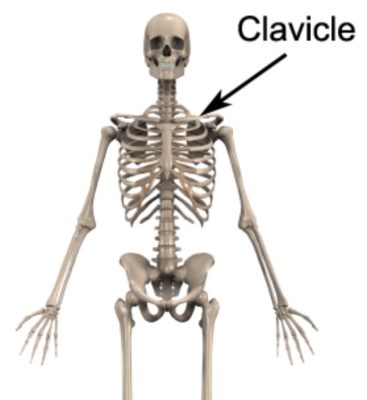Clavicle Anatomy: Structure and Function
Updated:
The clavicle is a long, curved bone that connects the shoulder blade (scapula) to the breastbone (sternum). It is the only bone that connects the upper limb to the axial skeleton, making it an important part of the skeletal system. The clavicle is also known as the collarbone, and it has a unique S-shape that allows it to absorb force and distribute it evenly. In this article, we will explore the anatomy of the clavicle, including its bony landmarks, muscular attachments, and related injuries.

Bony Landmarks of the Clavicle
The clavicle is a flat bone that has two ends and a middle section. The sternal end of the clavicle is the medial end that articulates with the sternum at the sternoclavicular joint. The acromial end of the clavicle is the lateral end that articulates with the acromion of the scapula at the acromioclavicular joint. The middle part of the clavicle is curved and has a smooth surface. It is also known as the shaft of the clavicle, and it is the thinnest part of the bone.
The clavicle also has several bony landmarks that provide attachment sites for ligaments and muscles. The trapezoid line is a rough ridge on the undersurface of the clavicle that serves as the attachment site for the trapezoid ligament. The conoid tubercle is a small bump on the undersurface of the clavicle that serves as the attachment site for the conoid ligament. The deltoid tuberosity is a rough area on the lateral aspect of the clavicle that serves as the attachment site for the deltoid muscle.
Clavicle Anatomy: Muscular Attachments
The clavicle has several muscular attachments that are important for the movement and stability of the shoulder joint. The subclavius muscle attaches to the undersurface of the clavicle and helps to depress and stabilize the shoulder girdle. The sternocleidomastoid muscle attaches to the clavicular head of the clavicle and helps to flex and rotate the head and neck. The trapezius muscle attaches to the trapezoid line of the clavicle and helps to elevate, retract, and rotate the scapula. The deltoid muscle attaches to the deltoid tuberosity of the clavicle and helps to abduct, flex, and extend the arm.
Injuries of the Clavicle
The clavicle is vulnerable to several types of injuries due to its position and function. Fractures of the clavicle are common in sports and accidents, and they can cause pain, swelling, and deformity of the shoulder. Dislocations of the sternoclavicular and acromioclavicular joints can also occur, causing instability and limited range of motion of the shoulder. Arthritis and bursitis can also affect the clavicle, causing pain and inflammation of the joint.
Conclusion
The clavicle is a unique bone that plays an important role in the stability and mobility of the shoulder joint. Its S-shape and bony landmarks provide attachment sites for ligaments and muscles, while its muscular attachments allow for a wide range of movement. However, injuries to the clavicle can cause significant pain and disability, requiring prompt medical attention. Understanding the anatomy of the clavicle can help to prevent and manage these injuries, allowing for optimal function and performance of the shoulder joint.
Clavicle Anatomy References:
- “Clavicle Anatomy” by Healthline (https://www.healthline.com/human-body-maps/clavicle-bone#1)
- “Clavicle Fracture” by American Academy of Orthopaedic Surgeons (https://orthoinfo.aaos.org/en/diseases–conditions/clavicle-fracture-broken-collarbone/)

Link to this Page
If you would like to link to this article on your website, simply copy the code below and add it to your page:
<a href="https://physioadvisor.com.au/health/anatomy/bones/clavicle-anatomy-structure-and-function”>Clavicle Anatomy: Structure and Function – PhysioAdvisor.com</a><br/>Learn about the anatomy of the clavicle including bony landmarks, muscular attachments, injuries on PhysioAdvisor.
Return to the top of Clavicle Anatomy: Structure and Function.
